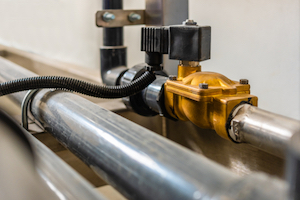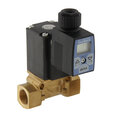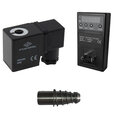Water Solenoid Valve Selection Criteria

Figure 1: A solenoid valve controlling the release of water through a drinking water system.
Water solenoid valves control water flow in residential, commercial, and industrial applications. They are used for filling tanks, controlling water flow in water treatment centers, filling washing machines, and more. Ensuring that the solenoid valve is specified properly for the application will ensure proper usage and less downtime (i.e. polluting potable water). This article reviews the main selection criteria for deciding which solenoid valve type to use in a water application.
Table of contents
- Valve ports/positions
- Valve body material
- Valve seal material
- Flow rate
- Connection size and type
- Valve function
- Valve voltage
- Operation
- Special features
- Water quality
- Cost
- FAQs
View our online selection of solenoid valves and buy one today!
Valve ports/positions
2/2-way and 3/2-way solenoid valves are used in water applications.
- 2/2-way: 2/2-way solenoid valves are selected for on/off water control applications.
- 3/2-way: 3/2-way solenoid valves are selected for more precise control, such as controlling water supply to different zones in irrigation systems and switching between various sources in water treatment systems.
Choose a proportional solenoid valve for precise flow control and variable flow requirements. Unlike traditional on/off solenoid valves, proportional solenoid valves can constantly vary the flow rate, allowing for precise flow control based on the input signal.
Valve body material
The body of a solenoid valve used in a water application will likely be stainless steel, brass, or PVC. Always ensure the selected valve material can withstand the system pressure and temperature. The seal material determines the valve's rated temperature range. A valve's precise pressure rating can vary among manufacturers.
- Stainless steel: Stainless steel is highly resistant to corrosion and suitable for a wide range of chemicals, making it ideal for aggressive or corrosive water applications. It can withstand high temperatures (up to 180 °C or 356 °F) and pressures (up to 250 bar or 3626 psi) and is highly resistant to hydraulic shock. However, it is more expensive than brass and PVC.
- Brass: Brass offers good corrosion resistance and is suitable for moderate temperature (up to 140 °C or 282 °F) and pressure applications (up to 140 bar or 2030 psi). It is cost-effective and widely used in general-purpose water applications. However, compared to stainless steel, brass is less resistant to highly corrosive chemicals.
- PVC (Plastic): Plastic is lightweight and cost-effective. It is suitable for low-temperature applications (up to 60 °C or 140 °F) and moderate pressure (up to 16 bar or 232 psi). However, it is unsuitable for high-temperature or high-pressure applications and has limited chemical resistance compared to stainless steel.
Valve seal material
Seals for solenoid valves are made from various materials. However, NBR, EPDM, and FKM seals are widely used in water applications.
- NBR: NBR is suitable for general applications. It can be safely used up to 60 °C (140 °F), sometimes 90 °C (194 °F). It offers good resistance to wear and tear but is not recommended for applications involving ozone or strong acids.
- EPDM: EPDM is commonly used in drinking water applications because it does not affect the water's taste. It can be safely used up to 130 °C (266 °F). However, it is not suitable for use with oils or hydrocarbons.
- FKM: Provides superior chemical resistance and can handle higher temperatures like 140 °C (284 °F). FKM is suitable for applications involving harsh chemicals or elevated temperatures. However, it is more costly than NBR and EPDM.
A steam valve is advised for applications with media at temperatures above 150 °C (302 °F).
Flow rate
Given the same size, solenoid valve designs have the highest to lowest flow rates in the following order: indirect, semi-direct, and direct. Knowing an application's desired flow rate before selecting a valve ensures that the chosen valve is not oversized or undersized.
- Oversized: Oversized valves are more expensive than the application requires. Indirect solenoid valves cycle on and off unnecessarily. If the flow's pressure is not high enough to hold open the oversized valve, it will suddenly close. This causes the pressure differential to equilibrate, again opening the valve to continue this cycle.
- Undersized: The application's flow rate will not be met.
For more information, refer to our valve sizing calculator.
Connection size and type
Choose a connection size that matches the pipe size or hose to which the valve will be connected. Standard sizes range from 5/64 to 2.5 inches (2 to 63.5 mm). Water solenoid valves are typically flanged or threaded (NPT, BSP).
Valve function
When selecting between normally closed (NC) and normally open (NO) solenoid valves for water applications, consider the default state of the valve when de-energized.
- Normally closed valves remain shut when not powered, making them suitable for applications where the valve should only open when needed, such as in irrigation systems or automated water dispensers.
- Normally open valves remain open when de-energized, which is ideal for applications requiring continuous flow with occasional shut-off, such as cooling or emergency safety systems.
Valve voltage
When selecting the voltage for a solenoid valve, consider the available power supply and the application's requirements. Standard voltage options include 12V DC, 24V AC/DC, 120V AC, and 230V AC. Low-voltage DC options, such as 12V or 24V, are often used in battery-powered or low-power applications for safety and energy efficiency. Higher voltage AC options, like 120V, are suitable for industrial or commercial settings where standard AC power is readily available.
Operation
Water applications use direct, indirect, and semi-direct-acting solenoid valves. Choose a direct-acting solenoid valve for applications requiring fast valve response at 0 bar. Conversely, choose an indirect solenoid valve for high flow rates and pressure applications.
Special features
- Media-separated: In a media-separated solenoid valve, the fluid does not contact the internal mechanical parts, such as the plunger and spring. These valves are particularly suitable for contaminated or corrosive fluid water, such as salt water.
- Latching: A latching valve is a special type of solenoid that changes state (open or closed) when power is supplied to the valve. Once the valve is fully open or closed, it does not consume power, making it ideal for battery-operated or low-power applications. This feature is particularly useful in remote or portable systems where power conservation is crucial.
Water quality
Lime scale can build up in a solenoid valve in hard water systems, causing it to operate incorrectly or prevent it from closing. In this scenario, AC solenoid valves can be held in a powered state, overheat, and break, whereas DC solenoid valves will not. Water softeners can be installed upstream of the solenoid valve, preventing hard water from damaging the device.
Cost
Direct-acting solenoid valves are the most cost-effective at small sizes (12.7 mm or 1/2 inch or less). However, at larger sizes, they require more extensive solenoids to operate effectively, making them less cost-effective than their semi-direct and indirect counterparts.
FAQs
What does a water solenoid valve do?
A water solenoid valve controls the water flow in a system by using an electromagnetic solenoid to open or close the valve.
What is the function of a solenoid valve in a water dispenser?
It controls the water flow, opening and closing in response to electrical signals to dispense water as needed.
What materials are suitable for a hot water solenoid valve?
Materials like brass or stainless steel are ideal for their heat resistance and durability.












